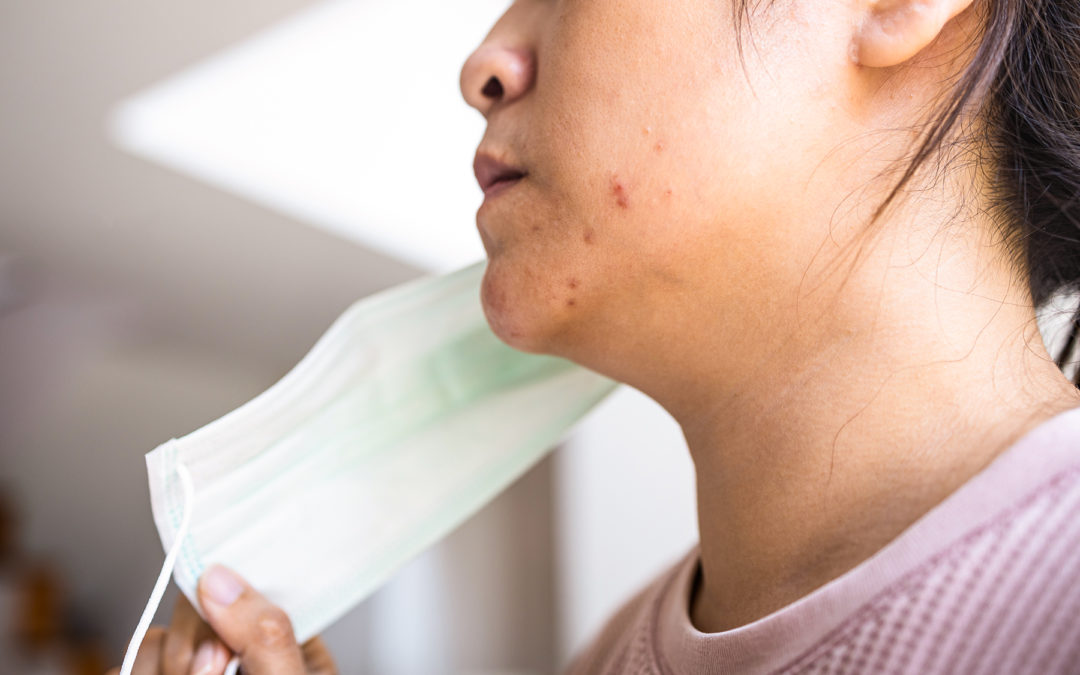Masks have become a regular part of our daily lives and many people are dealing with breakouts and irritation because of them. Regular skincare can go a long way in helping to prevent the dreaded acne and irritation caused by masks, also known as “maskne,” but in order to better prevent this condition, we should first understand what causes it.
Even when starting with clean skin and a clean mask, retained environmental humidity and moisture from breathing can make it easier for the mechanical friction of the mask to create small breaks in the skin. These breaks create an opportunity for bacteria, dirt, and oil to enter and clog pores. The cycle continues when those clogged pores become red and uncomfortable due to the friction of the mask.
In addition to protecting yourself and others against the virus by wearing a mask, we recommend investing time in mask hygiene and routine skincare to protect your skin from “maskne.”
How to avoid acne and irritation due to masks
1. Keep your skin clean.Cleanse your skin with warm water and a gentle cleanser at least twice a day. Rinse with cool water and pat the skin dry with a towel. Rubbing the skin with a towel may cause more irritation. Do not wash your face more often than necessary as it can strip the skin’s natural barrier.
Avoid wearing makeup under your mask when possible as makeup provides more debris to work itself into your pores and onto your mask. If you sweat a lot or wear your mask for long stretches of time, use a disposable cleansing cloth (that is free of artificial dyes or fragrances) once or twice throughout the day to keep both your face and your mask clean.
2. Moisturize often.Apply a lightweight moisturizer after cleansing your skin and at any time your skin feels dry. This will act as a barrier between the mask and your skin. Men should shave in the direction of the hair growth (as opposed to against the grain) to reduce inflammation.
For a moisturizer that won’t clog your pores, look for one that is labeled “noncomedogenic.” Plus, for bonus protection against the sun (and a mask-shaped tan line), choose a moisturizer with sunscreen.
3. Avoid using new products.If you already have a skincare routine, feel free to stick with it as long as it isn’t too irritating to your skin. Unless directed by your dermatologist, now is not the time to try abrasive, new products or tools, such as rough scrubs and cleansers or scrubbing pads. Implementing new techniques or introducing new chemicals could cause more irritation or make you vulnerable to a breakout.
4. Wash your mask.If you wear a disposable mask, make sure you are replacing it every day or as often as possible. If you wear a fabric mask, wash it nightly in a detergent made for sensitive skin or one without fragrance. It may help to have a few fabric masks on hand in case one gets dirty.
(Reminder: Always wash your hands before you put on your mask!)
5. Choose an appropriate mask and take mask breaks.In order to prevent irritation, make sure your mask has a proper fit. It should fit over your nose and mouth and sit securely under your chin. A snug fit against the sides of your face is important for protection against the virus as well as for avoiding skin friction.
When it’s possible and safe to do so, remove your mask. You don’t necessarily need to wear your mask in the car or at home with the people you live with. Giving your skin a break when you get a chance will naturally reduce the mechanical friction that leads to “maskne.”
How to treat acne and irritation due to masks
We’ve covered how to prevent maskne. But what about how to treat it?
Well, in many cases, treatment is the same as prevention: keep your skin clean and moisturized, wear a clean and properly fitted mask to reduce friction, and take breaks when possible. You can also put some basic pimple prevention tactics into place, such as avoiding touching your face, changing your pillowcases and towels often, and practicing stress-reduction.
To treat acne spots, you can start with an over-the-counter product containing benzoyl peroxide or salicylic acid. They are available as acne washes or topical spot treatments. Apply the latter by lightly dabbing it directly on the spot; don’t rub it in. If you aren’t already using a spot treatment, begin with lower strength products to prevent reactions.
If your symptoms of irritation or acne persist despite following these recommendations, speak to your dermatologist.
Dr. Cara Hennings is a board-certified dermatologist, specializing in both adult and pediatric dermatology. She treats a variety of skin conditions including skin cancers, benign growths, acne, eczema, rosacea, and psoriasis. She conducts rigorous skin examinations to detect skin cancers. Her practice also offers a wide range of cosmetic dermatology services such as Botox, lasers, and soft tissue fillers.
Erlanger Dermatology offers comprehensive treatment for a variety of skin conditions including acne. To schedule an appointment or view our monthly cosmetic specials, visit our website or call 423-778-5693.







